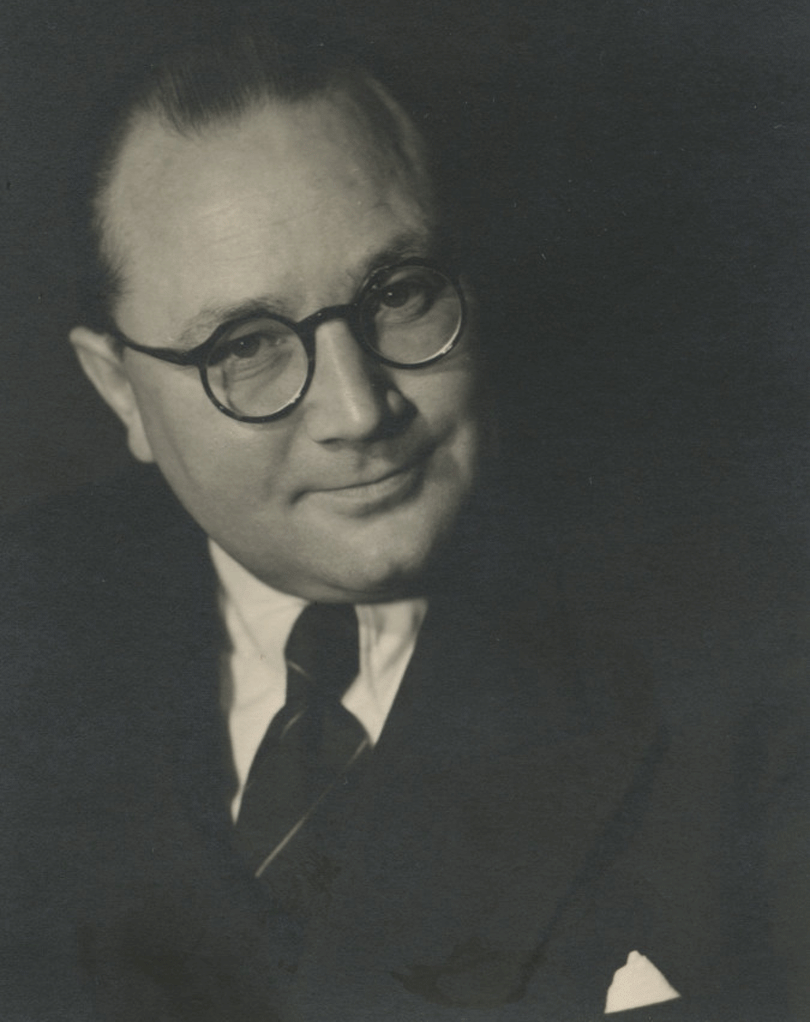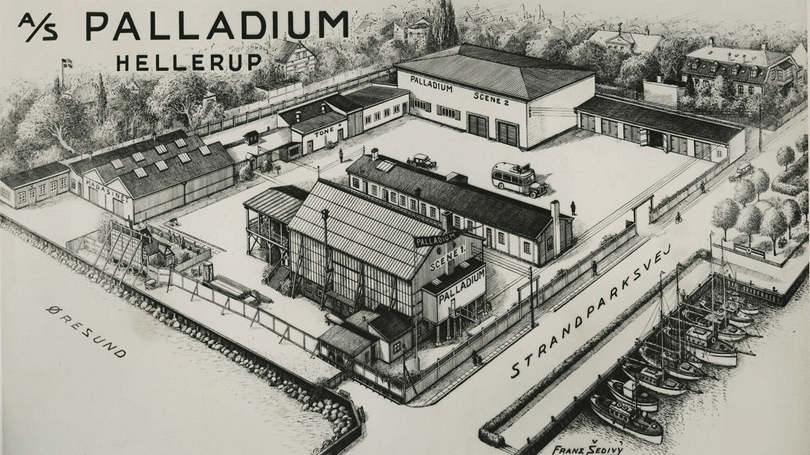
Palladium was originally a Swedish company founded by Lars Björck (1884-1926). In 1915 Björck had founded Skandinavisk Filmscentral, which distributed films and owned a big chain of cinemas in Sweden. The chain’s flagship was the palatial Palladium cinema in Stockholm. Looking to add a production company to his operation, Björck in spring 1919 acquired the studios of two Danish film companies, Kinografen and Dania Biofilm, in Copenhagen. The new production company, named Palladium, was conceived as a pan-Scandinavian film company with studios in Denmark and stage facilities in Sweden. The company had big ambitions and its films were intended for the world market. One of its first films was supposed to have been an adaptation of Selma Lagerlöf’s The Story of Gösta Berling, but it never came to fruition, like so many of the other big productions Palladium had planned. Among the films Palladium did make was Jeftas Dotter (1919), directed by the former Nordisk Film director Robert Dinesen, but neither it nor Ödets redskap (1919), another film by Dinesen, was successful.
Fy & Bi, a hit duo
Palladium had better luck with its comedies. Palladium had hired the director Lau Lauritzen, another former Nordisk Film man, and in 1920 made him artistic director as well. As a contract director at Nordisk Film, Lauritzen had been uncommonly prodigious, directing nearly 200 short comedies in 1914-1919. In a 1921 film for Palladium, Film, Flirt og Forlovelse, Lauritzen introduced two Mutt and Jeff-like tramps, Fyrtaarnet and Bivognen (Fy & Bi for short, billed as Long and Short in the UK). The comedic duo’s films were a big hit abroad, and Palladium was the only Danish film company in the 1920s that still had an international impact.
Unfortunately for him, Björck did not get a chance to be a part of Palladium’s success. At the end of 1920, he had pulled out of the company to free up capital to pay back some of the many loans he had taken to realise his grand scheme of a pan-Scandinavian, vertically integrated film company. Palladium in Denmark was acquired by Svend Nielsen (1891-1958), who was previously the company’s chief financial officer. Björck was declared bankrupt in December 1921 and the following year he sold his interests to AB Svensk Filmindustri.
From Berlin to Hellerup
Palladium’s film production was based on two to four annual Fyrtaarnet and Bivognen releases. In spring 1925, Lauritzen travelled to Spain to shoot Don Quixote with Carl Schenstøm (Fyrtaarnet) and Harald Madsen (Bivognen) as Don Quixote and Sancho Panza. Palladium’s studio on Strandparksvej in Hellerup (a few kilometres north of Cophagen) lay idle, which created an opportunity for Dreyer, who was just back from shooting Michael in Berlin, to do a film for Palladium. Master of the House would be Dreyer’s last Danish film in almost 20 years. Immediately after finishing Master of the House, he went to Norway to shoot The Bride of Glomdal (1925). Master of the House was well received and also very important for Dreyer’s further career. The film caused a stir, especially in France, paving the way for the financing of Dreyer’s masterwork, The Passion of Joan of Arc (1928).
Interlude at Nordisk Film
Dreyer returned to Copenhagen in 1934 after eight years abroad. Sound films had arrived a few years before and the Danish film industry had been reduced to selling to the domestic market only. Producers played it safe: the name of the game was popular actors in comedies with song and music. No one had any use for Dreyer and his experimental films, and so in 1936 he went back to journalism, now at the newspaper B.T. In 1942, thanks to the writer Ebbe Neergaard and the filmmaker Mogens Skot-Hansen, Nordisk Film hired Dreyer to direct a short film, Good Mothers (1942).
While shooting Good Mothers, Dreyer began negotiations with Nordisk Film about realising an adaptation of Hans Wiers-Jensen’s play Anne Pedersdotter titled Day of Wrath. It would prove to be a drawn-out affair. The negotiations dragged on for almost a year before Nordisk finally rejected the project as directed by Dreyer. They considered him too "peculiar" and unable to do anything but experimental films. They did, however, give him their permission to try to sell Day of Wrath to Palladium.

Day of Wrath vs. 'ballyhoo films'
With the help of Skot-Hansen, who could present the handsome production accounts for Good Mothers, Dreyer offered Day of Wrath to Tage Nielsen (1900-1971), who had taken over as head of Palladium after his brother, Svend Nielsen. In April 1943, Nielsen gave Dreyer the go-ahead to shoot his first Danish feature in 18 years.
The reason for Palladium’s nerve in taking on the "peculiar" Dreyer is probably found in the flowering of the Danish film industry during the Occupation. Danish cinemas were prohibited from showing films from countries with which Germany were at war – first the popular American and British movies, then films from the Soviet Union and France. Audiences flocked to Danish films, and film production grew. Of the total 124 features produced between 1940 and 1949, 82 were made during the Occupation. The four big studios – Nordisk Film, Palladium, ASA and Saga, which was founded in 1942 – during the Occupation found the courage to take a chance on films other than musical comedies.
Day of Wrath opened in November 1943 to generally negative reviews. The film had been an expensive production for Palladium, and it irked Nielsen that his company’s more experimental gambles, including Elverhøj (1939), Sommerglæder (1940) and Day of Wrath, were not profitable. Though he personally found it intolerable, Palladium to stay afloat had to keep making "ballyhoo films" – Nielsen’s term for audience-friendly films that made their money back. Eventually, this focus on "ballyhoo films" would get Palladium in serious trouble and, paradoxically, indirectly lead to the realisation of Dreyer’s last two features.
Palladium’s production licence
To avoid the monopolisation of the Danish film industry, it was stated in the National Film Act of 1938 that productions companies could not also be cinema operators. With one exception: Danish production companies could obtain a so-called production licence, a result of the government’s wish to support domestic film production. Operating cinemas was very good business for the Danish production companies. Unlike other cinema owners, production companies were exempt from paying an "amusement tax" on their profits when they reached a certain level. As a condition for obtaining – and, not least, keeping – its favourable production licence, a company had to maintain a production of three to four films a year. Plus, the films had to be of a certain quality. Palladium had owned the concession to run Copenhagen’s big first-run cinema Palladium since 1938 and thus was under some pressure to conform to the requirements.
Dreyer was Palladium’s seal of good cinema quality
After the war, Danish film production returned to its default setting of audience-friendly comedies. De røde Heste (The Chestnut Horses) (1950), the first in ASA’s series of films from the rustic-romantic novels of Morten Korch, set the artistic bar for Danish films in the following years. However, unlike ASA, which made sure to produce serious issue films, such as Cafe Paradis (1950) and Farlig Ungdom (1953), Palladium got in trouble. In late 1953, the Danish Film Council (Filmrådet), which administered the licences, warned Palladium that the quality of the company’s productions "in recent years overall [had] been of a quality that in the long term was insufficient to meet the requirements on the holder of a production licence" (cf. Dinnesen and Kau, 1983, p. 113). Faced with losing its production licence, Palladium in 1954 launched the production of Dreyer’s The Word, and the Film Council preserved the company’s production licence.
In the early 1960s, Palladium again found itself in hot water. This is perhaps best evidenced by a sample of the companies’ titles: Eventyrrejsen (The Adventurous Journey) (1960), Jetpiloter (Jet Pilots) (1961), Komtessen (The Countess’ Daughter) (1961), Landsbylægen (The Village Doctor) (1961), Drømmen om det hvide slot (The Dream of the White Castle) (1962), Vi har det jo dejligt (Everything’s Dandy) (1963), and Slottet (The Castle) (1964). For two consecutive years the Film Council warned Palladium to raise the quality of its films or lose its production licence. As it had done in the 1950s, Palladium won over the Film Council by launching a new Dreyer project, Gertrud, Dreyer’s last film.
Palladium next proceeded to dish out lusty gals and guys in Annelise Meineche’s lightweight folk comedies that anticipated the company’s notorious sengekant (bedside) films in the 1970s.
By Isak Thorsen | 23. May
